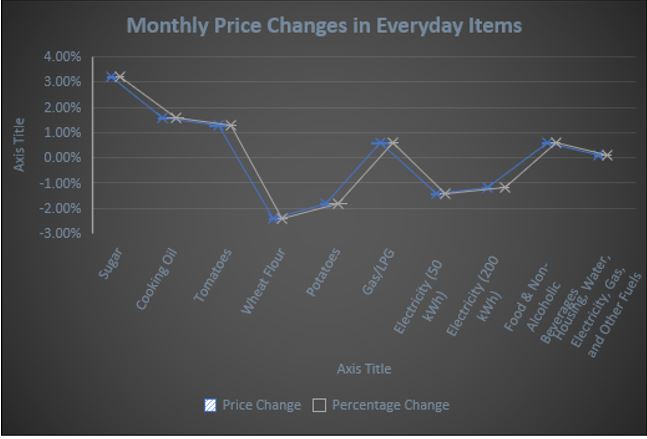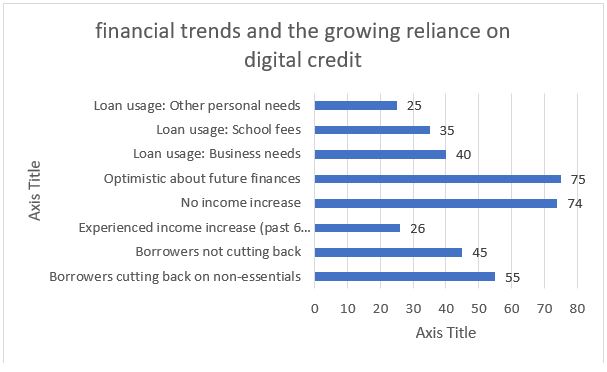
Kenya's inflation crisis has shifted from just a news story to an
urgent reality for families nationwide.
The recent Consumer Price Index reveals a stark truth: many
households are forced to make heart-wrenching decisions. They are forced to choose between
paying rent or buying groceries, covering school fees, or repaying loans.
The Consumer Price Index (CPI), as defined by the Kenya National
Bureau of Statistics, serves as an essential macroeconomic indicator used to
monitor price fluctuations and their implications for policy decision-making.
It is quantified as the weighted average change in retail prices
consumers incur for a designated basket of goods and services.
This critical indicator, compiled monthly by the Kenya National
Bureau of Statistics (KNBS) across 50 urban zones, reveals a detailed narrative
about the cost of living.
The March 2025 data shows annual inflation accelerating to 3.5 per cent up from 3.3 per cent in February, meaning Kenyan families now need 3.5 per cent more to
maintain the same standard of living.
This creeping inflation is most evident in supermarket aisles, where the Food and Non-Alcoholic Beverages Index rose 0.6% in just one month.
Staple items like sugar (+3.2 per cent), cooking oil (+1.6 per cent), and tomatoes
(+1.3 per cent) have become noticeably more expensive, although small reprieves were
provided by slight declines in wheat flour (-2.4 per cent) and potatoes (-1.8 per cent).
The housing sector tells a similar story of financial strain, with
the Housing, Water, Electricity, Gas and Other Fuels Index inching up 0.1 per cent,
propelled by a 0.6 per cent surge in gas/LPG prices that hit hardest at the kitchen
stove, even as electricity costs saw modest relief with 50 kWh and 200 kWh
prices dropping 1.4 per cent and 1.2 per cent respectively.
Behind these statistics are real families making painful budget
decisions. Jane Wanjiru, a mother of three in Nairobi's Jericho, watches
helplessly as her grocery bill balloons from Sh500 to Sh800 for the same basic
items.
Wanjiru, a hairdresser at Uhuru Market, discusses the challenges
she faces in balancing her business and personal finances.
“You see, once fuel prices go up, everything just goes haywire,”
she says while eyeing the tomatoes at Wakulima Market.
“Matatu fare shoots up, milk delivery becomes expensive, and the
shopkeeper adds their own on top to recover transport costs. In the end, it’s
us who suffer. You’re forced to choose between buying unga or paying school
fees—it’s crazy!”
The situation worsens in informal settlements. I speak with
twenty-nine-year-old Monica Tata, a resident of Kawangware.
Tata describes some of her struggles as a mother of two and a
house manager in Lavington, earning KES 15,000 monthly. She describes skipping
meals to feed her children and sometimes being unable to afford her daughter's
school fees.
“A few years ago, we could get by on my little salary since things
were not as expensive,” she recounts.
“My daughter attends a public school only because it’s what we can
afford. It breaks my heart because my daughter is so bright, and she deserves
more.”
Moreover, Tata said her family could no longer afford any food
beyond githeri due to rising living costs.
“The economy is unbearable. I can’t remember the last time my
family ate anything aside from githeri,” Tata said.
“I have to save for my children to at least go to school. My
daughter’s school keeps sending notes about unpaid fees, and I am completely
stretched.”
Macro-finance specialist Hassan Manyara frames this as more than
an economic challenge but a full-blown social crisis with generational
consequences.
"When parents must choose between feeding their children and
paying school fees, when workers lose motivation because their salaries buy
less each month, we're not just talking about inflation percentages—we're
watching Kenya's human capital erode in real time," he warns.
Manyara points to Kenya's shrinking disposable incomes, which are
creating a vicious cycle of reduced consumer spending that further weakens
businesses, leading to job cuts and further spending reductions.
“Despite constitutional guarantees, consumer protection in Kenya
remains almost non-existent. Article 46 of the Constitution ensures the right
to safe, reasonably priced, and accurately labelled goods and services."
He finishes by saying governmental agencies such as the
Competition Authority and the Kenya Bureau of Standards, which are tasked with
enforcement and supported by the Consumer Protection Act (2012)—are not doing
enough to ensure consumer protection and standards are realised.
Manyara offers a solution by proposing comprehensive tax reforms
aligned with Adam Smith's principles, shifting the burdens to high-impact
sectors like manufacturing and commercial agriculture, while eliminating
nuisance taxes that strangle small traders.
"Our tax policies should stimulate growth, not just extract
revenue from struggling citizens," he argues, noting that neighbouring
Tanzania has managed to keep food inflation below 2 per cent through targeted agricultural
investments.
Nyandemo says Rwanda and Ethiopia compellingly model their
approach through the streamlining of business taxes and the slashing of
nuisance taxes on small traders, while offering incentives for agro-processing
and manufacturing.
“Rwanda cut corporate rates applicable for priority sectors to
15 per cent, and Ethiopia exempted farm inputs of all types from VAT, which led to some
meaningful growth for both without fueling any inflation, which the World Bank
attributed,” he said.
Nyandemo argues that Smith’s principles of efficiency, equity, and
economic stimulus can work well in practice.
“Kenya’s fixation with taxing survivalist enterprises only deepens
the existing poverty, while Rwanda's success could easily be replicated through
smarter fiscal policies: much more investment into sectors that really drive
prosperity, relatively fewer burdens upon the vulnerable,” he said.
Auditor and financial analyst Gladwell Maingi advocates for a
multi-pronged approach, including strategic subsidies for staple foods modelled
after Rwanda's.
Maingi also describes Rwanda’s strategic subsidy model, aligned
with its Economic Development and Poverty Reduction Strategy (EDPRS), which
targets key sectors like agriculture (e.g., e-voucher fertilisers) and energy
(e.g., subsidised solar) to boost productivity and inclusion.
She attributes its success to precision targeting, rigorous
accountability, and political goodwill.
Maingi particularly criticises government waste that undermines
development, citing the 2024 Auditor General's report revealing Sh18 billion
spent on dubious contracts and unpaid bills while the public wage bill balloons
with politically motivated hires.
Moreover, Maingi noted how worrying it was that the Treasury
couldn't account for over KES 7 billion in government assets.
“They don’t even have a complete asset register—that’s basic
accounting. If this were a business, it would be a scandal.”
Maingi also criticises the Telkom shares transaction that was
never approved by Parliament.
“We’re seeing billions allocated without proper documentation. The
Auditor General flagged Sh6.2 billion spent on Telkom shares that was never
approved by Parliament. That’s not just poor oversight; it’s fiscal
indiscipline at the highest level.”
According to Maingi, foreign investors have taken notice of these
dysfunctions, with the Nairobi Securities Exchange reporting a 40% drop in
foreign portfolio inflows compared to 2023.
"Investors see the unmanaged inflation, the corruption
scandals, and the policy inconsistencies, and they're voting with their
feet," says Maingi.
Meanwhile, fintech and microfinance expert Melanie Ambasa breaks
down the Digital Financial Services Association of Kenya (DFSAK) report, in
which Tala highlights key financial pressures faced by Kenyans, exacerbated by
inflation.
"What we're seeing is a fundamental shift—digital loans are
no longer just for emergencies; they've become a regular part of how families
bridge the gap between paychecks."
Ambasa explains that data from the 2024 DFSAK and Tala reports
show that over half of borrowers—fifty-five percent—are cutting back on
essentials like food and transport to repay loans.
“Despite seventy-five percent expressing optimism about the
future, only 26% saw income growth in the last six months. Most loans are used
for business expenses, school fees, and personal needs,” Ambasa said.
Ambasa noted that the growing reliance on digital credit presents
both opportunities and risks.
On one hand, she says, mobile loans provide quick access to funds
for school fees or business needs, but she also warns of a potential debt trap.
"The convenience of digital lending comes with real
dangers," cautions Ambasa.
"When used responsibly, these tools can help weather
financial storms, but without proper safeguards, they can deepen financial
stress."
The report highlights particular challenges for microfinance
institutions, as demand for loans increases, which in turn increases default
risks.
"We're walking a tightrope—we want to serve our customers,
but we also have to maintain responsible lending practices," Ambasa said.
Moreover, Ambasa emphasises the urgent need for financial
education.
"Literacy programs aren't just nice to have anymore—they're
essential armor in this economic climate."
While the government has implemented stopgap measures, such as
fuel subsidies and tax breaks for farmers, experts like Ambasa agree that these
measures are simply not enough.
As Jane Wanjiru, the mother of three we spoke to, puts it,
"Inflation isn't just numbers in the news; our investment dreams are being
crushed as we’re living cheque to cheque. God, just help us."
“Without urgent, coordinated action addressing both the economic
and governance dimensions of this crisis, we will continue to see the rise of
diminishing opportunities and growing desperation among many Kenyans,” Ambasa
said.
The project received support from the Thomson
Reuters Foundation as part of its global work aiming to strengthen free, fair
and informed societies. Any financial assistance or support provided to the
journalist has no editorial influence. The content of this article belongs
solely to the author and is not endorsed by or associated with the Thomson
Reuters Foundation, Thomson Reuters, Reuters, nor any other affiliates.













